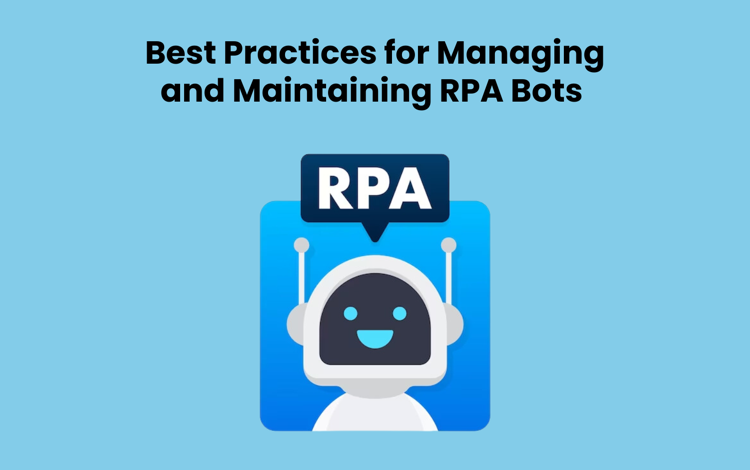
Best Practices for Managing and Maintaining RPA Bots
In the world of technology, Robotic Process Automation (RPA) has emerged as a pivotal tool for businesses seeking to streamline operations and enhance efficiency. As RPA continues to gain traction across various industries, the importance of effectively managing and maintaining RPA bots cannot be overstated.
For those looking to deepen their understanding or embark on a career in this field, enrolling in an RPA Course Online is a great starting point. This blog aims to guide you through the best practices for managing and maintaining RPA Bot, ensuring that these digital workers deliver optimal performance and value.
Table of Contents
- Understanding RPA Bots
- Continuous Monitoring and Analysis
- Regular Updates and Upgrades
- Scalability and Flexibility
- Security and Compliance
- Training and Knowledge Sharing
- Effective Collaboration Between Human and Digital Workforces
- Regular Maintenance and Quality Assurance
- Choosing the Right Tools and Platforms
- Documentation and Standardization
- Post-Implementation Review and Feedback
- Conclusion
Understanding RPA Bots
Before diving into management practices, it’s essential to understand what RPA bots are. An RPA bot is a type of software application that automates repetitive and routine tasks to enhance productivity and efficiency. These bots can interact with various systems and applications just like humans but with greater speed and accuracy.
1. Continuous Monitoring and Analysis
Performance Metrics
Regular monitoring of bot performance is crucial. Key performance indicators (KPIs) such as accuracy, efficiency, and downtime should be tracked to evaluate the bot’s effectiveness.
Exception Handling
Despite their efficiency, RPA bots may encounter exceptions or errors. Implementing robust exception-handling mechanisms ensures that these issues are quickly identified and resolved.
2. Regular Updates and Upgrades
Software Updates
Like any software, RPA bots require regular updates, which can include bug fixes, new features, or compatibility enhancements.
Adaptation to Changing Environments
Business processes and IT environments are dynamic. Regularly updating bots to align with these changes is essential to maintain their relevance and efficiency.
3. Scalability and Flexibility
Scalable Architecture
Design your RPA infrastructure to be scalable. This allows for easy addition or removal of bots as business needs change.
Flexible Design
Develop bots with flexibility in mind. This makes it easier to modify them when processes change, reducing the need for complete redevelopment.
4. Security and Compliance
Data Security
Ensure that your RPA bots comply with data security standards. Sensitive data handled by bots should be encrypted and securely stored.
Regulatory Compliance
Stay abreast of regulatory changes that might affect your RPA deployment. Ensure bots operate within legal and ethical boundaries.
5. Training and Knowledge Sharing
Continuous Learning
Invest in training programs for your team, like an RPA course online. This keeps them updated on the latest RPA trends and technologies.
Knowledge Sharing
Foster a culture of knowledge sharing to ensure widespread dissemination of insights and learnings about bot management.
6. Effective Collaboration Between Human and Digital Workforces
Defining Roles
Clearly define the roles and responsibilities of human employees and RPA bots. This ensures a harmonious and productive working relationship.
Human Oversight
While RPA bots operate independently, human oversight is essential to manage exceptions and make strategic decisions.
7. Regular Maintenance and Quality Assurance
Scheduled Maintenance
Regular maintenance ensures smooth bot functioning and detects potential issues.
Quality Checks
Implement quality assurance processes to ensure the bots’ output meets the required standards.
8. Choosing the Right Tools and Platforms
Fit-for-Purpose Tools
Select RPA tools and platforms that align with your business needs and objectives. Consider factors like scalability, ease of use, and integration capabilities.
Vendor Support
Choose vendors that offer robust support and training resources. Having access to this information can be extremely helpful in resolving any issues and improving the performance of the chatbot.
9. Documentation and Standardization
Comprehensive Documentation
Maintain detailed documentation for each bot. This includes its purpose, design, and any changes made over time.
Process Standardisation
Standardize RPA processes across the organization. This simplifies management and maintenance while ensuring consistency in performance.
10. Post-Implementation Review and Feedback
Regular Reviews
Conduct post-implementation reviews to assess the impact of RPA bots on business processes and identify areas for improvement.
Feedback Loops
Establish feedback loops with end-users and stakeholders. Their insights can be critical in refining and improving RPA strategies.
Conclusion
Effectively managing and maintaining RPA bots is a dynamic and ongoing process. It requires a strategic approach encompassing continuous monitoring, regular updates, scalability, security, and collaboration between human and digital workforces. Organisations can achieve maximum benefits of RPA by following best practices, leading to improved efficiency, cost reduction, and overall performance enhancement. Whether you’re just starting with an Advanced Technology Courses or are an experienced practitioner, understanding these principles is key to success in RPA bot management.

